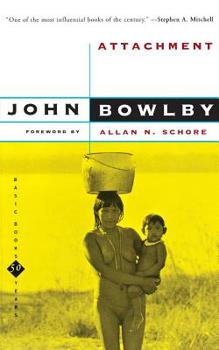Book Overview
This first volume of John Bowlby's Attachment and Loss series examines the nature of the child's ties to the mother. Beginning with a discussion of instinctive behavior, its causation, functioning, and ontogeny, Bowlby proceeds to a theoretical formulation of attachment behavior--how it develops, how it is maintained, what functions it fulfills.In the fifteen years since Attachment was first published, there have been major developments...
Format:Paperback
Language:English
ISBN:0465005438
ISBN13:9780465005437
Release Date:September 1983
Publisher:Basic Books
Length:464 Pages
Weight:1.01 lbs.
Dimensions:1.0" x 5.1" x 8.2"
Customer Reviews
3 ratings
A Groundbreaking Classic on Young Child Development
Published by Thriftbooks.com User , 21 years ago
This first volume of John Bowlby's trilogy on Attachment and Loss expands and builds upon an article he published in 1958 in the International Journal of Psycho-Analysis titled "The Nature of the Child's Tie to His Mother", which is perhaps a more telling title than that of the book itself. Attachment, as a technical term in behavioural biology, is first used in describing instinctive mother-following behaviours of young mammals and birds (first observed and reported in delightful accounts by the Austrian ethologist Konrad Lorenz in the 1930's). By comparing data collected during and after the Second World War by childcare workers and researchers in U.K. and North America, Bowlby found a striking common pattern of distressed behaviours among young children between the ages of one and three when separated from mother for an extended period: first in Protest, then Despair and finally Detachment - a psychopathological state when a child becomes socially uninitiated and withdrawn, even to his returning mother. Bowlby then postulates that physical proximity to a mother-figure is essential to a child's development of cognitive capacities, especially during a sensitive period around six months to two years after birth. Attachment behaviours, like those of young mammals and birds, are present in the human baby too. This has since led to a blossoming of research activities in development psychology and psychoanalysis, as well as neurophysiology recently, which supplies much fresh evidence about the young brain and its phenomenal maturing in the first two years. Attachment theory has since contributed significantly to understanding of our own selves, informed the age-old philosophical debate on nature or nurture, and brought our attention to fundamental issues in child-rearing such as sensitive periods of development, the difference between attachment (conducive to security) and dependence (symptomatic of insecurity), the distinction between anxiety from separation and fear of the unfamiliar, etc. This new edition is a timely reprint of a classic account of attachment theory as formulated by the originator. While primarily an academic work, with a few chapters deemed more for an academic jury (about Freud and instinctive behaviours, etc.), it is mostly very readable, and certainly captivating to those with access to young babies, of whose behaviours are given an enlightening perspective. This volume focuses on attachment, with subsequent volumes on its loss in temporary and permanent terms respectively.
Seminal work. Not yet surpassed
Published by Thriftbooks.com User , 21 years ago
The work of John Bowlby (who was most certainly not a Behaviorist) is the work of genius. His importance in the field of developmental psychology has yet to be surpassed. It cannot be minimized.
important
Published by Thriftbooks.com User , 24 years ago
Classic, vitally important work. The writing is just so simple and clear, and the topic just so important, this book is quite worthwhile reading for any student (in the broadest sense) of psychology. Bowlby is an original researcher on attachment between infants and their caregivers. He describes his own and others' research projects and analyzes them in a theoretical framework about instinctive behavior. Why would it be important for children to have attachments? What sorts of attachments would we expect them to have, and what do they have? These are questions Bowlby addresses.







